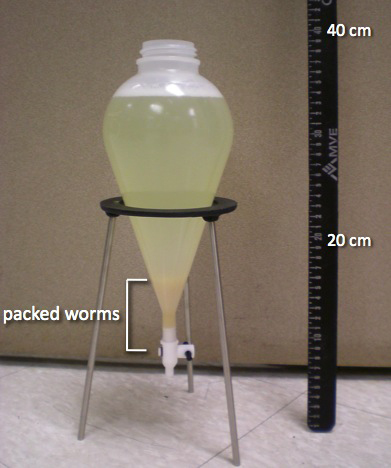Although it is easy to grow worms in large quantities in liquid medium, harvesting worms is troublesome, especially when the culture is big. There are several options to collect worms (Hope, 1999). Centrifugation is the most typical procedure, yet in many cases the residual bacteria supplied as food in the culture is also precipitated and is hard to get rid of. A sucrose floatation step to obtain a pure worm sample is effective but difficult to scale up. An alternative way to harvest worms is to chill the culture flasks on ice, allow the worms to settle, then aspirate off the supernatant. This is easy and effective, but not all experiments tolerate a prolonged chilling step. Another harvesting option is to collect worms with mesh, which may be hard to keep sterile.
We use a Nalgene® separatory funnel (#4300), which is made of polypropylene with a Teflon TFE stopcock. Worms hardly stick to it. Although the funnel is autoclavable (stopcock is not autoclavable), we use ethanol to sterilize it. An 8-cm tripod (inner diameter) works well with both 500 ml and 1000 ml funnels. If you fully open the stopcock, the worms will come out within 2 seconds. The worm pellet should be pure. If you want it to be extra pure, you can repeat the steps with new buffer.
Figures

- Place a separatory funnel on a tripod.
- Close the stopcock.
- Pour the liquid culture into the funnel.
- Allow worms to settle for ~10 min at room temp.
- Gently open the stopcock over a collecting tube.
- Close stopcock when you have collected all worms.
References
Hope, IA. (1999). C. elegans. A practical approach. (New York: Oxford University Press).
Articles submitted to the Worm Breeder's Gazette should not be cited in bibliographies. Material contained here should be treated as personal communication and cited as such only with the consent of the author.
Leave a Reply
You must be logged in to post a comment.